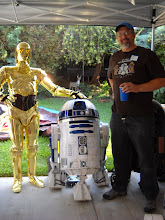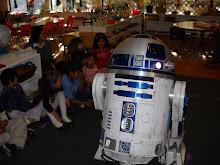
Then I sand that edge clean. Next I glue the longer outer piece onto those. This piece closes up the passage inside for the wiring. Next, I set up the table saw to make most of the cuts down the blank. You can start to see the shape of the leg come out here (no, the saw isn't running here).

Cutting them this way helps me get a straight, consistent cut. Since all of my blanks are the same size, I can set the saw up once and then do all of them quickly. Just flip the piece over to do the other side. Before making these cuts, I scraped the excess glue off of the sides from yesterday's glue ups. Otherwise, the glue will push the piece out from the fence and mess up the cut. I slide a chisel down the glue drips when they were about 2 hours old. They were dry enough then to come off, but soft enough to be pliable. Then I hit the side with the belt sander a bit before this cut. I also marked the point where the leading edge of the saw blade underneath would come to and made sure not to cut too far into this piece. Very important. I'll finish this cut--since the table saw leaves a curved cut in there--on the bandsaw.
Next I cut the angles under the shoulders with the bandsaw. I've got a wide blade with a pretty high tooth count on there right now, so cuts like this are straight and pretty clean. The edges that are left will need some filing, and then some cleaning up with an orbital sander.

Next I've roughed out the curve across the top of the shoulders on the bandsaw, and then I take it to the belt sander again for cleaning up. Starting too look more like a leg.

Next up, it's time to deal with those frustrating under shoulder pockets. On my first set of legs I did not find a really efficient way to do these. Victor Franco, with Mike Senna's help, has worked out a trick by routing out these pockets oversized and then lining them with thin MDF. His results are nice once all the joints and cuts are filled and sanded. I'm not going to go that far. 90% of the pocket cuts will be covered by the little greeblies that fit in here. But I do think I'll copy part of their method to rout them out. So I've made a template on 1/8" MDF for cutting. If you haven't done it, take your R2 plans to kinkos on a jump drive and get them printed up full size. I had an extra full size leg blueprint for this:

I sprayed some spray on adhesive to the MDF and to the back of the paper and then just smoothed it on. Then I cut it out on the bandsaw. I've cut the pocket profile slightly large--about 1/16" over--so that I can use the template collar on my router for this. The next stage will be tricky. I think what I am going to do is this. I've got the two big inboard pieces of the legs glued together for the both sets of legs. I think I'll screw the third outboard piece onto those and then cut them all into the shape like the one above. Then I'll take the outboard piece off and cut these pockets with the router. Then I'll put the outboard piece back on with glue. We'll see what sort of results I can get inside the pockets this way. I think it will be clean enough to require a minimum of additional work. But that's all for tomorrow.
Once those pockets are cut, I can glue the final two pieces on the inside and outside of the ankles and finish them out. That will be tricky too. But I'll be able to explain with pictures better when I'm there.







No comments:
Post a Comment